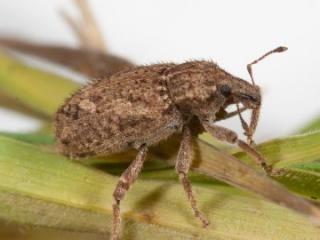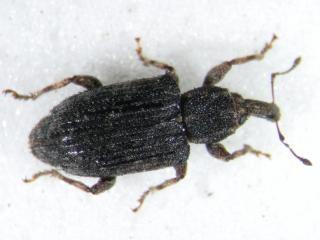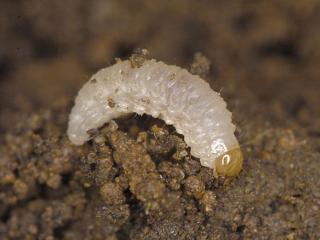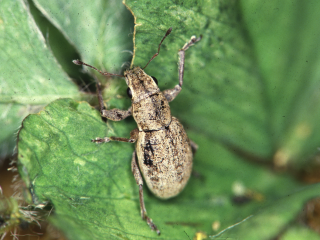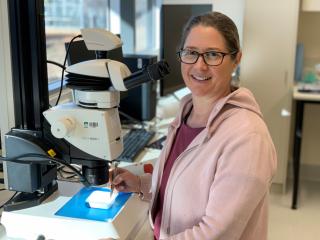Identifying weevils
- Goomalling
An Agworld user has recently reported finding vegetable weevils in canola near Goomalling. The canola ranged from cotyledon to first true leaf stage.
Weevil species
Four species of weevils typically damage canola: vegetable weevil, desiantha (spotted vegetable) weevil, small lucerne weevil and Fuller’s rose weevil.
Adult vegetable weevils are about 10mm long with two short white stripes at an angle on each side of its abdomen. They will attack canola and some broadleaf pasture plants, especially capeweed. They are often camouflaged amongst stubble and trash and tend to hide during the day.
Vegetable weevils can lay eggs on canola. The eggs hatch into the larval stage in early winter. Larvae feed on the plants on which they hatched. Larvae have a black head, are legless, cream coloured and can be confused with caterpillars.
Desiantha weevil adults are mottled grey-black in colour with grey flecks on the abdomen, and have the typical elongated weevil snout. They grow up to 7mm long and are flightless. Adults chew cotyledons, leaves and stems of canola plants, and may eat small plants down to ground level, while the larvae feed below ground on cereals.
The larvae of desiantha weevils are white legless creatures that grow to 6mm long with orange/brown heads. They remain under the soil where they feed on the germinating cereal seed or stem, they can be difficult to find if in low numbers.
Small lucerne weevil adults are about 5mm long, light grey in colour with a white stripe on each side. Adults will attack geminating lucerne, pasture legumes and canola. Small lucerne weevil will hide under stubble and may not come into contact with insecticides. After spraying, check for new damage in crops or for live beetles before seeding.
Adult Fuller’s rose weevils are about 8mm long, have an elongated body and are grey with a yellow stripe running across the side on the first two body segments and a lateral yellow stripe on each side of the abdomen.
Larvae of Fuller’s rose and small lucerne weevil, are difficult to distinguish between as they both have a white head, with black jaws, are legless and cream coloured. They are found underground, feeding on roots of plants. Small lucerne weevil larvae have been known to cause damage to lucerne.
Adult vegetable weevils often harbour in rock heaps and remnant bush areas and move into the adjoining canola crop from these refuges. The other three weevils have been known to cause damage across the paddock.
Weevils can be very hard to find as they hide and play dead with their legs tucked, which helps them blend in with their surroundings. Pitfall traps placed into the ground can be an effective way to find weevils.
If you are unsure of the type of weevil you have found in your canola crop use the PestFacts WA Reporter app to request an identification by our entomologists.
Diagnosing weevil damage
All adult weevils chew off parts of leaves and cotyledons, giving them a serrated appearance, and can eat plants down to ground level at high numbers.
Desiantha weevil larvae feed on the underground parts of cereal seedlings and can cause a reduction in plant growth, wilting and eventual death of plants.
Damage from vegetable weevil is usually restricted to paddock edges or where capeweed was in abundance the previous year.
Managing canola weevils
Weevils can be a frustrating pest as they can survive spray applications of insecticides at registered rates due to their behaviour of hiding during the day. For this reason, it can be more effective to spray in the evening when weevils are active.
Desiantha weevil numbers can be reduced by effective control of grass weeds in the previous season and of the green bridge following summer rainfall.
The only treatment for Desiantha weevil larvae in cereals is to sow with seed treated with chlorpyrifos.
For insecticide recommendations on managing vegetable weevils in canola, refer to DPIRD’s 2023 autumn winter insecticide spray guide. The vegetable weevil requires higher rates of insecticides than most pests of canola.
For more information on weevils visit DPIRD's Diagnosing weevils in canola and Diagnosing Desiantha weevil in cereals pages.
For more information contact Research scientist Svetlana Micic, Albany on +61 (0)8 9892 8591.
Article authors: Cindy Webster (DPIRD Narrogin), Svetlana Micic (DPIRD Albany) and Alan Lord (DPIRD South Perth).
Downy mildew in canola
- Williams
- Narrogin
- Great Southern
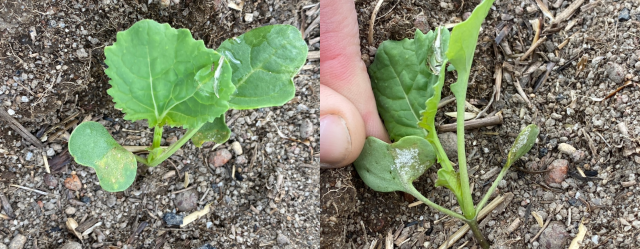
Hilary Wittwer (Farmworks) has reported that downy mildew is present on canola in Williams and Narrogin after significant rain being received in the area in April. Canola cotyledons are turning yellow.
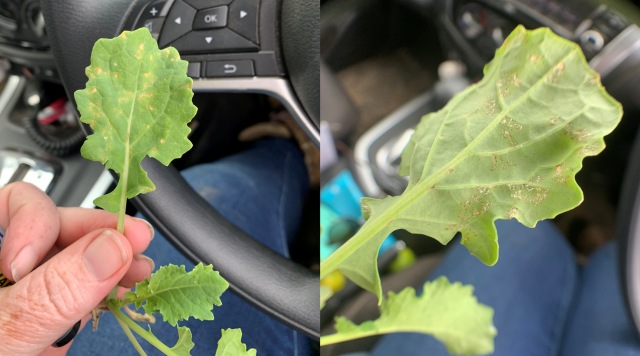
Agronomists are also finding downy mildew on canola in early sown crops in the Great Southern region.
Canola downy mildew in WA mainly affects young cotyledons and the first few true leaves, however the latter are usually less severely affected.
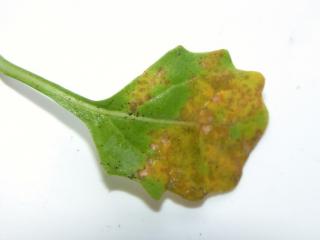
Symptoms of downy mildew typically appear as yellowed cotyledons and lower leaves. Older leaves display angular yellow lesions on the upper leaf surface. Sometimes the lesions appear as creamish, circular to irregular spots of varying sizes on the upper leaf surface that turn brownish over time.
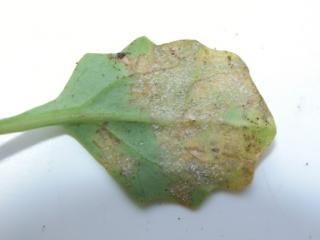
Examination of the underside of these leaves often shows a corresponding patch of white fluffy growth, although this can become less apparent with age or turn beige in colour, or have sand adhering to it. Severely affected cotyledons shrivel up and senesce prematurely.
While some early seedling mortality may occur, canola plants usually overcome the disease as they get older and as conditions cool.
Disease is generally favoured by temperatures of 15-18◦C and wet soil coupled with high humidity. Under such conditions, disease spreads very rapidly.
Downy mildew in WA is mainly soil borne but may be seed borne or carried over on the green bridge. Once the primary lesions are formed on the underside of the leaves, secondary spread of the disease occurs via the airborne spores formed in the primary lesions. Disease epidemics are sporadic, therefore developing control strategies against downy mildew can be very challenging.
Most of the current canola varieties are susceptible to downy mildew.
Seed dressings with the active ingredient metalaxyl-m can help suppress downy mildew in seedlings. Syngenta have developed a seed dressing based around Saltro® that will soon be registered for downy mildew control on canola. This is expected to be available for seeding next year and may be worth considering if downy mildew is a consistent problem on your farm.
More information about this disease can be found at DPIRD’s Diagnosing downy mildew in canola page.
For more information on downy mildew or damping off in canola contact Research scientists Andrea Hills, Esperance on +61 (0)8 9083 1144, Ciara Beard, Geraldton on +61 (0)8 9956 8504 or Jean Galloway, Northam on +61 (0)8 9690 2172.
Article authors: Andrea Hills (DPIRD Esperance) and Cindy Webster (DPIRD Narrogin).
Article input: Jean Galloway (DPIRD Northam).
Meet PestFacts WA team member - Bec Severtson
Bec Severtson is a Research scientist based in Northam’s DPIRD office and will be working with the PestFacts WA team to assist with PestFacts WA service outputs.
Bec is also working in other DPIRD Crop Protection projects, conducting research on the Dongara weevil, and reviewing alternative methods of insect pest control to reduce chemical use in broad acre cropping.
Bec has worked at the Department in several entomology roles over the years. Bec originally joined as a Quarantine Officer and worked in the South Perth entomology team for five years before providing technical support on the Gorgon LNG Project quarantine program and working in the stored grain insect resistance program. Bec also worked on large invertebrate biodiversity projects at Curtin University and was a senior botanist in environmental consultancies for the mining and oil and gas industries which involved travelling to remote parts of Western Australia and Timor Leste.
Bec has a Bachelor of Science in Biology with Honours from Curtin University. Her research focussed on grassland ecology on cattle stations in the Pilbara region of WA.
Bec’s interest in entomology and biology in general was sparked by a childhood spent in rural mining towns in Queensland, South Australia and WA. This interest has extended to agricultural entomology in the past five years after moving to a farming community.
Bec looks forward to assisting the team communicate crop protection information to WA grain growers.
Article author: Bec Severtson (DPIRD Northam).

